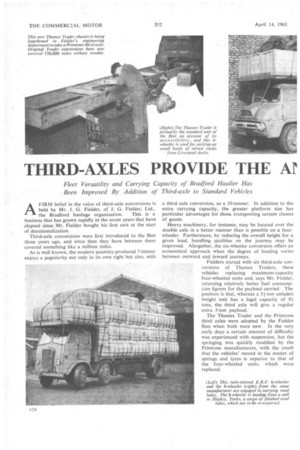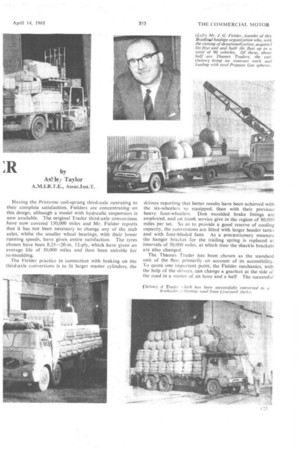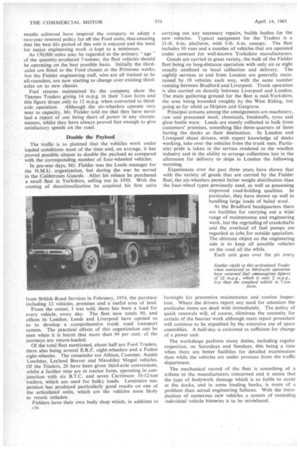THIRD-AXLES PROVIDE THE Ar
Page 64

Page 65

Page 66

If you've noticed an error in this article please click here to report it so we can fix it.
Fleet Versatility and Carrying Capacity of Bradford Haulier Has Been Improved By Addition of Third-axle to Standard Vehicles by Asiky Taylor
A.M.I.R.T.E., Associnst.T.
AFIRM belief in the value of third-axle conversions is held by Mr. J. G. Fielder, of I. G. Fielder, Ltd.,
the Bradford haulage organization. This is a business that has grown rapidly in the seven years that have elapsed since Mr. Fielder bought his first unit at the start of denationalization.
Third-axle conversions were first introduced to the fleet three years ago, and since then they have between them covered something like a million miles.
As is well known, the modern quantity-produced 7-tonner enjoys a popularity not only in its own right but also, with a third axle conversion, as a 10-tonner. In addition to the extra carrying capacity, the greater platform size has particular advantages for those transporting certain classes of goods.
Heavy machinery, for instance, may be located over the double axle in a better manner than is possible on a fourwheeler. Furthermore, by reducing the overall height for a given load, handling qualities on the journey may be improved. Altogether, the six-wheeler conversion offers an economical approach when the degree of loading varies between outward and inward journeys.
Fielders started with six third-axle conversions of Thames Traders, these vehicles replacing maximum-capacity four-wheeled units and says Mr. Fielder, returning relatively better fuel consumption figures for the payload carried. The position is that, whereas a 51-ton unladen weight unit has a legal capacity of 8+ tons, the third axle will give a regular extra 5-ton payload.
The Thames Trader and the Primrose third axles were adopted by the Fielder fleet when both were new. In the very early days a certain amount of difficulty was experienced with suspension, but the springing was quickly modified by the Primrose manufacturers, with the result that the vehicles' record in the matter of springs and tyres is superior to that of the four-wheeled units, which were replaced. Having the Primrose coil-sprung third-axle operating to their complete satisfaction, Fielders are concentrating on this design, although a model with hydraulic suspension is now available. The original Trader third-axle conversions have now covered 150,000 miles and Mr. Fielder reports that it has not been necessary to change any of the stub axles, whilst the smaller wheel bearings, with their lower running speeds, have given entire satisfaction. The tyres chosen have been 8.25-20-in. 12-ply, which have given an average life of 50,000 miles and then been suitable for re-moulding.
The Fielder practice in connection with braking on the third-axle conversions is to fit larger master cylinders, the drivers reporting that better results have been achieved with the six-wheelers so equipped, than with their previous heavy four-wheelers. Don moulded brake linings are employed, and on trunk service give in the region of 80,000 miles per set. So as to provide a good reserve of cooling capacity, the conversions are fitted with larger header tanks and with four-bladed fans. As a precautionary measure the hanger bracket for the trailing spring is replaced at intervals of 50,000 miles, at which time the shackle brackets are also changed.
The Thames Trader has been chosen as the standard unit of the fleet primarily on account of its accessibility. To quote one important point, the Fielder mechanics, with the help of the drivers, can change a gearbox at the side of the road in a matter of an hour and a half. The successful results achieved have inspired the company to adopt a two-year renewal policy for all the Ford units, thus ensuring that the best life period of this unit is enjoyed and the need for major engineering work is kept to a minimum.
As 150,000 miles may be regarded as the primary " age " of the quantity-produced 7-tonner, the fleet vehicles should be operating on the best possible basis. Initially the thirdaxles are fitted to the Ford chassis at the Primrose works, but the Fielder engineering staff, who are all trained to be all-rounders, are now starting to change over existing thirdaxles on to new chassis.
Fuel returns maintained by the company show the Thames Traders giving 14 m.p.g. in their 7-ton form and this figure drops only to 12 m.p.g. when converted to thirdaxle operation. Although the six-wheelers operate very near to capacity, Mr. Fielder told me that they have never had a report of one being short of power in any circumstances, whilst they have always proved fast enough to give satisfactory speeds on the road.
Double the Payload
The traffic is so planned that the vehicles work under loaded conditions most of the time and, on average, it has proved possible almost to double the payload as compared with the corresponding number of four-wheeled vehicles.
In pre-war days, Mr. Fielder was the Leeds manager for the N.M.U. organization, but during the war he served in the Coldstream Guards. After his release he purchased a small fleet in Yorkshire, selling out in 1950. With the coming of denationalization he acquired his first units from British Road Services in February, 1954, the purchase including 12 vehicles, premises and a useful area of land.
From the outset, I was told, there has been a load for every vehicle, every day. The fleet now totals 90, and offices in London, Leeds and Liverpool have opened so as to develop a comprehensive trunk road transport system. The practical effects of this organization can be seen when it is learnt that more than 99 per cent. of the journeys are return-loaded.
Of the total fleet mentioned, about half are Ford Traders, there also being several E.R.F. eight-wheelers and a Foden eight-wheeler. The remainder are Albion, Commer, Austin Loadstar, Leyland Beaver and Maudslay Mogul vehicles. Of the Traders, 20 have been given third-axle conversions, whilst a further nine are in tractor form, operating in conjunction with six B.T.C. and seven Carrimore 10-12-ton trailers, which are used for bulky loads. Laminaire suspension has produced particularly good results on one of the articulated units, which are the vehicles most likely to return unladen.
Fielders have their own body shop which, in addition to (-26 carrying out any necessary repairs, builds bodies for the new vehicles. Typical equipment for the Traders is a 21-ft. 6-in, platform, with 5-ft. 6-in. canopy. The fleet includes 10 vans and a number of vehicles that are operated under contract for well-known Yorkshire manufacturers.
Goods are carried in great variety, the bulk of the Fielder fleet being on long-distance operation with only six or eight usually confined to local collection and delivery. The nightly services to and from London are generally maintained by 10 vehicles each way, with the same number running between Bradford and Liverpool. Trunk operation is also carried on directly between Liverpool and London. The main gathering ground for the fleet is mid-Yorkshire, the area being bounded roughly by the West Riding, but going as far afield as Skipton and Gargrave.
Principal streams among the consignments are machinery, raw and processed wool, chemicals, foodstuffs, tyres and glass bottle ware. Loads are mostly collected in bulk from customers' premises, something like three-quarters of them having the docks as their destination. In London and Liverpool shunt drivers, with expert knowledge of docks working, take over the vehicles from the trunk men. Particular pride is taken in the service rendered to the woollen industry and in the ability to arrange collections late in the afternoon for delivery to ships in London the following morning.
Experiences over the past three years have shown that with the variety of goods that are carried by the Fielder fleet, the six-wheelers permit better weight distribution than the four-wheel types previously used, as well as possessing improved road-holding qualities. In particular, they have shown up well in handling large loads of baled wool.
At the Bradford headquarters there are facilities for carrying out a wide range of maintenance and engineering work, but the regrinding of crankshafts and the overhaul of fuel pumps are regarded as jobs for outside specialists. The ultimate object on the engineering side is to keep all possible vehicles on the road all the while.
Each unit goes over the pit every fortnight for preventive maintenance and routine inspection. Where the drivers report any need for attention the particular items are dealt with immediately. The policy of quick renewals will, of course, eliminate the necessity for certain of the heavier work although main repair procedure will continue to be expedited by the extensive use of spare assemblies. A half-day is reckoned as sufficient for change of a power unit.
The workshops perform many duties, including regular inspection, on Saturdays and Sundays, this being a time when there are better facilities for detailed examination than while the vehicles are under pressure from the traffic department.
The mechanical record of the fleet is something of a tribute to the manufacturers concerned and it seems that the type of bodywork damage which is so liable to occur at the docks, and in some loading banks, is more of a problem than actual engineering failures. With the introduction of numerous new vehicles a system of recording individual vehicle histories is to be introduced.
































































































































